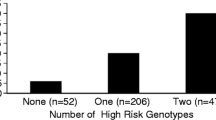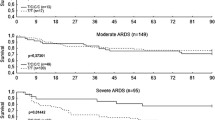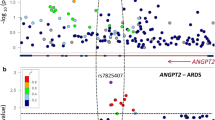Abstract
Objective
The insertion/deletion (I/D) of a 289 base pair Alu repeat sequence polymorphism in the angiotensin-converting enzyme gene (ACE) has been shown to predict susceptibility and outcome in the acute respiratory distress syndrome (ARDS). We hypothesized that the I/D polymorphism also confers susceptibility to sepsis and is a predisposing factor for morbidity and mortality of patients with severe sepsis.
Design and setting
Case-control study including 212 consecutive patients fulfilling criteria for severe sepsis admitted to a Spanish network of postsurgical and critical care units, and 364 population-based controls. Susceptibility to severe sepsis was evaluated as primary outcome; mortality in severe sepsis, susceptibility to sepsis-induced ARDS, and mortality in sepsis-induced ARDS were examined as secondary outcomes. An additive model of inheritance in which patients were classified into three genotype groups (II, ID, and DD) was used for association testing.
Measurements and results
Genotype and allele frequencies of I/D were distributed similarly in all septic, ARDS, and non-ARDS patients and in population-based controls. ACE I/D polymorphism was not associated with severe sepsis susceptibility or mortality. The ACE I/D polymorphism was associated neither with sepsis-induced ARDS susceptibility (p = 0.895) or mortality (p = 0.950). These results remained nonsignificant when adjusted for other covariates using multiple logistic regression analysis or Kaplan–Meier estimates of 28-day survival.
Conclusions
Our data do not support an association of the ACE gene I/D polymorphism with susceptibility or mortality in severe sepsis or with sepsis-induced ARDS in Spanish patients.

Similar content being viewed by others
References
Igic R, Behnia R (2003) Properties and distribution of angiotensin I converting enzyme. Curr Pharm Des 9:697–706
Imai Y, Kuba K, Rao S, Huan Y, Guo F, Guan B, Yang P, Sarao R, Wada T, Leong-Poi H, Crackower MA, Fukamizu A, Hui CC, Hein L, Uhlig S, Slutsky AS, Jian C, Penninger JM (2005) Angiotensin-converting enzyme 2 protects from severe acute lung failure. Nature 436:112–116
Rigat B, Hubert C, Alhenc-Gelas F, Cambien F, Corvol P, Soubrier F (1990) An insertion/deletion polymorphism in the angiotensin I-converting enzyme gene accounting for half the variance of serum enzyme levels. J Clin Invest 86:1343–1346
Tiret L, Rigat B, Visvikis S, Breda C, Corvol P, Cambien F, Soubrier F (1992) Evidence, from combined segregation and linkage analysis, that a variant of the angiotensin I-converting enzyme (ACE) gene controls plasma ACE levels. Am J Hum Genet 51:197–205
Suehiro T, Morita T, Inoue M, Kumon Y, Ikeda Y, Hashimoto K (2004) Increased amount of the angiotensin-converting enzyme (ACE) mRNA originating from the ACE allele with deletion. Hum Genet 115:91–96
Zhu X, McKenzie CA, Forrester T, Nickerson DA, Broeckel U, Schunkert H, Doering A, Jacob HJ, Cooper RS, Rieder MJ (2000) Localization of a small genomic region associated with elevated ACE. Am J Hum Genet 67:1144–1153
Cox R, Bouzekri N, Martin S, Southam L, Hugill A, Golamaully M, Cooper R, Adeyemo A, Soubier F, Ward R, Lathrop GM, Matsuda F, Farrall M (2002) Angiotensin-1-converting enzyme (ACE) plasma concentration is influenced by multiple ACE-linked quantitative trait nucleotides. Hum Mol Genet 11:2969–2977
Sayed-Tabatabaei FA, Oostra BA, Isaacs A, van Duijn CM, Witteman JC (2006) ACE polymorphisms. Circ Res 98:1123–1133
Furuya K, Yamaguchi E, Itoh A, Hizawa N, Ohnuma N, Kojima J, Kodama N, Kawakami Y (1996) Deletion polymorphism in the angiotensin I converting enzyme (ACE) gene as a risk factor for sarcoidosis. Thorax 51:777–780
Alia P, Mana J, Capdevila O, Alvarez A, Navarro MA (2005) Association between ACE gene I/D polymorphism and clinical presentation and prognosis of sarcoidosis. Scand J Clin Lab Invest 65:691–697
Veneciano J, Crestani B, Mestari F, Klouche W, Neukrich F, Hacein-Bey S, Gnevieve D, Aubier M (1997) High frequency of a deletion polymorphism of the angiotensin-converting enzyme gene in asthma. J Allergy Clin Immunol 99:53–57
Harding D, Baines PB, Brull D, Vassiliou V, Ellis I, Hart A, Thomson AP, Humphries SE, Montgomery HE (2002) Severity of meningococcal disease in children and the angiotensin-converting enzyme insertion/deletion polymorphism. Am J Respir Crit Care Med 165:1103–1106
Schut AF, Bleumink GS, Stricker BH, Hofman A, Witteman JC, Pols HA, Deckers JW, Deinum J, van Duijn CM (2004) Angiotensin converting enzyme insertion/deletion polymorphism and the risk of heart failure in hypertensive subjects. Eur Heart J 25:2143–2148
Salonen J, Kesaniemi YA, Ukkola O (2006) Association between angiotensin-converting enzyme insertion/deletion polymorphism and treatment response in type 2 diabetic patients. Eur J Intern Med 17:115–119
Serrano N, Díaz LA, Páez MC, Mesa CM, Cifuentes R, Monterrosa A, González A, Smeeth L, Hingorani AD, Casas JP (2006) Angiotensin-converting enzyme I/D polymorphism and preeclampsia risk: evidence of small-study bias. PLoS Medicine 3:2304–2316
Yamamoto T, Wang L, Shimakura K, Sanaka M, Koike Y, Mineshita S (1997) Angiotensin II-induced pulmonary edema in a rabbit model. Jpn J Pharmacol 73:33–40
Marshall RP, Webb S, Bellingan GJ, Montgomery HE, Chaudhari B, McAnulty RJ, Humphries SE, Hill MR, Laurent GJ (2002) Angiotensin converting enzyme insertion/deletion polymorphism is associated with susceptibility and outcome in acute respiratory distress syndrome. Am J Respir Crit Care Med 166:646–650
Jerng JS, Yu CJ, Wang HC, Chen KY, Cheng SL, Yang PC (2006) Polymorphism of the angiotensin-converting enzyme gene affects the outcome of acute respiratory distress syndrome. Crit Care Med 34:1001–1006
Levy MM, Fink MP, Marshall JC, Abraham E, Angus D, Cook D, Cohen J, Opal SM, Vincent JL, Ramsay G (2003) 2001 SCCM/ESICM/ACCP/ATS/SIS International Sepsis Definitions Conference. Crit Care Med 31:1250–1256
Villar J, Manzano JJ, Blazquez MA, Quintana J, Lubillo S (1991) Multiple system organ failure in acute respiratory failure. J Crit Care 6:75–80
Bernard GR, Artigas A, Brigham KL, Carlet J, Falke K, Hudson L, Lamy M, LeGall JR, Morris A (1994) The American-European Consensus Conference on ARDS: definitions, mechanisms, relevant outcomes and clinical trial coordination. Am J Respir Crit Care Med 149:818–829
Vincent JL, de Mendonca A, Cantraine F, Moreno R, Takala J, Suter PM, Sprung CL, Colardyn F, Blecher S (1998) Use of the SOFA score to assess the incidence of organ dysfunction/failure in intensive care units: results of a multicenter, prospective study. Working group on “sepsis-related problems” of the European Society of Intensive Care Medicine. Crit Care Med 26:1767–1768
Maca-Meyer N, Villar J, Perez-Mendez L, Cabrera de Leon A, Flores C (2004) A tale of aborigines, conquerors, and slaves: Alu insertion polymorphisms and the peopling of Canary Islands. Ann Hum Genet 68:600–605
Cooper DN, Nussbaum RL, Krawczak M (2002) Proposed guidelines for papers describing DNA polymorphism-disease associations. Hum Genet 110:207–208
Hattersley AT, McCarthy MI (2005) What makes a good genetic associations study. Lancet 366:1315–1323
Clark MF, Baudouin SV (2006) A systematic review of the quality of genetic association studies in human sepsis. Intensive Care Med 32:1706–1712
Flores C, Maca-Meyer N, Perez-Mendez L, Sanguesa R, Espinosa E, Muriel A, Blanco J, Villar J, GRECIA group, GEN-SEP group (2006) A CXCL2 tandem repeat promoter polymorphism is associated with susceptibility to severe sepsis in the Spanish population. Genes Immunol 7:141–149
Raymond M, Rousset F (1995) GENEPOP (ver 1.1.2): population genetics software for exact tests and ecumenicism. J Hered 86:248–249
Hao K, Li C, Rosenow C, Wong WH (2004) Detect and adjust for population stratification in population-based association study using genomic control markers: an application of Affymetrix Genechip Human Mapping 10K array. Eur J Hum Genet 12:1001–1006
Steffens M, Lamina C, Illig T, Bettecken T, Vogler R, Entz P, Suk EK, Toliat R, Klopp N, Caliebe A, Konig IR, Kohler K, Ludemann J, Lacava AD, Fimmers R, Lichtner P, Ziegler A, Wolf A, Krawczak M, Nurnberg P, Hampe J, Schreiber S, Meitinger T, Wichmann HE, Roeder K, Wienker TF, Baur MP (2006) SNP-Based Analysis of Genetic Substructure in the German Population. Hum Hered 62:20–29
Engel C, Brunkhorst FM, Bone HG, Brunkhorst R, Gerlach H, Grond S, Gruendling M, Huhle G, Jaschinski U, John S, Mayer K, Oppert M, Olthoff D, Quintel M, Ragaller M, Rossaint R, Stuber F, Weiler N, Welte T, Bogatsch H, Hartog C, Loeffler M, Reinhart K (2007) Epidemiology of sepsis in Germany: results from a national prospective multicenter study. Intensive Care Med 33:606–618
Brun-Buisson C, Minelli C, Bertolini G, Brazzi L, Pimentel J, Lewandowski K, Bion J, Romand JA, Villar J, Thorsteinsson A, Damas P, Armaganidis A, Lemaire F, ALIVE Study Group (2004) Epidemiology and outcome of acute lung injury in European intensive care units. Results from the ALIVE study. Intensive Care Med 30:51–61
Seldin MF, Shigeta R, Villoslada P, Selmi C, Tuomilehto J, Silva G, Belmont JW, Klareskog L, Gregersen PK (2006) European population substructure: clustering of northern and southern populations. PLoS Genetics 2:1339–1351
Cornuet J-M, Piry S, Luikart G, Estoup A, Solignac M (1999) New methods employing multilocus genotypes to select or exclude populations as origins of individuals. Genetics 153:1989–2000
Comas D, Calafell F, Benchemsi N, Helal A, Lefranc G, Stoneking M, Batzer MA, Bertranpetit J, Sajantila A (2000) Alu insertion polymorphisms in NW Africa and the Iberian Peninsula: evidence for a strong genetic boundary through the Gibraltar Straits. Hum Genet 107:312–319
Vineis P, McMichael AJ (1998) Bias and confounding in molecular epidemiological studies: special considerations. Carcinogenesis 19:2063–2067
Weiss ST (2001) Association studies in asthma genetics. Am J Respir Crit Care Med 164:2014–2015
Casey L, Krieger B, Kohler J, Rice C, Oparil S, Szidon P (1981) Decreased serum angiotensin converting enzyme in adult respiratory distress syndrome associated with sepsis: a preliminary report. Crit Care Med 9:651–654
Acknowledgements
Members of GEN-SEP are: J. Villar, E. Espinosa, R. Sangüesa, M. Muros, L. Pérez-Méndez, S. Lubillo, N. Maca-Meyer, C. Flores, and P. Tejera. Members of GRECIA are: J. Blanco; A. Muriel; V. Sagrado and J. C. Ballesteros, Medicina Intensiva Hospital Clínico Universitario, Salamanca; F. Taboada and G. Muñiz, Medicina Intensiva, Hospital Central de Asturias, Oviedo; F. Gandía and F. Bobillo, Medicina Intensiva, Hospital Clinico Universitario, Valladolid; L. Tamayo and A. G. Labattut, Medicina Intensiva, Hospital General de Soria, Soria; J. Collado, Medicina Intensiva, Complejo Hospitalario de León, León; M. Valledor and M. T. Antuña, Medicina Intensiva, Hospital San Agustín, Aviles; M. J. López and J. J. Cortina, Medicina Intensiva, Hospital General de Segovia, Segovia; T. Saldaña, A. Caballero, and T. Álvarez, Medicina Intensiva, Hospital Virgen de la Concha, Zamora; M. De Frutos, Medicina Intensiva, Hospital General Yagüe, Burgos; J. Guerra, Medicina Intensiva, Hospital de Cabueñes, Gijón; B. Álvarez and J. Sandoval, Medicina Intensiva, Hospital del Bierzo, Ponferrada.
Author information
Authors and Affiliations
Corresponding author
Additional information
This research was supported by grants from FUNCIS (53/04) and the Ministerio de Educación y Ciencia, Spain (SAF2004-06833). J.V. is the principal investigator in both grants.
The authors named above wrote this article on behalf of the GRECIA and GEN-SEP groups. The members of the GRECIA and GEN-SEP groups are listed under Acknowledgements at the end of the article.
J. Villar, C. Flores, and L. Pérez-Méndez contributed equally to this work.
Electronic supplementary material
Rights and permissions
About this article
Cite this article
Villar, J., Flores, C., Pérez-Méndez, L. et al. Angiotensin-converting enzyme insertion/deletion polymorphism is not associated with susceptibility and outcome in sepsis and acute respiratory distress syndrome. Intensive Care Med 34, 488–495 (2008). https://doi.org/10.1007/s00134-007-0937-z
Received:
Accepted:
Published:
Issue Date:
DOI: https://doi.org/10.1007/s00134-007-0937-z




